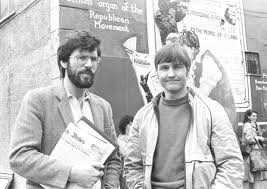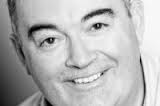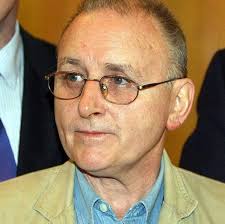Way back in 1988, nearly three decades ago, Sinn Fein’s Foreign Affairs department set in motion a process in America that, in a roundabout way, would become a building block in the then still secret, largely invisible peace process that six years later would produce the first IRA ceasefire and all that followed it, not least Sinn Fein’s bid to be in government on both sides of the Border.
Under the direction of SF’s Director of Foreign Affairs, Ted Howell – a reticent but enormously influential activist who doubled as chairman of the party’s Think Tank, the body that directed the peace process for the SF leadership – two young SF workers were dispatched to the United States to tour Noraid units throughout the country, assess their willingness to embrace a new political role and report back to the Sinn Fein President Gerry Adams.
 |
Ted Howell and Gerry Adams pictured during the Good Friday Agreement negotiations
|
Although no-one active in the Provisionals’ support group could know it then, their mission would mean that Noraid’s days were numbered and that within a few years the group’s rank and file would largely be left by the wayside and Noraid itself replaced by a body devoted not to anti-British agitation but almost entirely to raising huge sums of money from corporations and America’s wealthy to further Sinn Fein’s electoral ambitions.
But how all that happened is a most curious tale.
Noraid – or Irish Northern Aid to give the group its proper title – had been formed back in 1970 in the wake of the IRA split to be the public face of Irish republicanism in America. Its principal function was to raise money, ostensibly to support the families of imprisoned or interned Provisional IRA members, and to campaign publicly for British withdrawal from Northern Ireland.
 |
A Noraid banner is carried in Ohio
|
While Noraid was often accused by its enemies in the British and Irish governments, and many in the media, of sending money and guns to the IRA, its primary role was to be the major vehicle for Irish-American antipathy to the British presence in Northern Ireland. Its importance to the Provisional leadership, especially those based in the North, could therefore never be overstated and securing Noraid’s allegiance or at least acquiescence was vital.
From the outset there was never any doubt that Noraid’s sympathies would be with the Provos. The Official IRA’s flirtation with Marxism, the run down of the military side under the Goulding leadership and, crucially, the obvious intention to ditch abstentionism meant that Noraid’s founders were always going to take the Provo side as the split widened from 1970 onwards.
If anything, Noraid’s real affinity was with the Northern gunmen whose commitment to physical force appeared to be immutable, although politically its activists probably had more in common with the older and more conservative Southern leadership.
 |
Gerry Adams and Martin Galvin in younger, happier days
|
When the IRA declared a ceasefire in early 1975, for instance, Noraid’s leaders sided with the Young Turks interned in Long Kesh, people like Gerry Adams, Ivor Bell and Brendan Hughes, who argued that the ceasefire was a disaster and that the leadership responsible for leading the IRA in that direction was foolish and misguided.
And it remained that way, with Noraid content to see the Adams’ leadership overtake and overthrow the rule of Ruairi O Bradaigh and Daithi O Conaill.
Until 1986.
In that year the logic of the electoral strategy followed by the Provos since the 1981 hunger strikes produced the first dent in the armour of abstentionism, the cardinal belief of traditional republicanism, and with it came the first shards of doubt in the ranks of Noraid.
The breach made in the abstentionist doctrine by Sinn Fein at that year’s ard-fheis was admittedly a partial one – Sinn Fein would take seats in the Dublin parliament but not in Belfast or London – but it clearly was the just the first installment in a process that had only one conclusion: Sinn Fein would one day take seats in a Northern parliament and with that would come an inevitable dilution in the party’s political theology.
And so it was that in 1988, with doubts simmering in the ranks of Noraid, that Ted Howell dispatched Declan Kearney and Oistin MacBride on a six week tour of Noraid units in ten areas where the organisation was active: New York city & state, Pennsylvania, Illinois, Michigan, Ohio, Washington DC, Vermont, New Hampshire, Massachusetts and Connecticut.
 |
Declan Kearney (extreme left) and Gerry Adams (extreme right) pose with the British ambassador in Dublin Dominick Chilcott
|
If Howell was concerned about the likely reaction to this expedition from Noraid’s rank and file he had chosen well in Kearney and McBride. It would have been difficult to have found two figures more likely to have been received well by militant Irish-America.
Declan Kearney has in recent years risen to the top of Sinn Fein and is now widely regarded as the most revisionist of all the new generation of Provisional leaders but in 1988 he was better known in America as the son of Oliver Kearney, a popular and respected figure stateside.
A former SDLP stalwart, Oliver Kearney had fallen out with John Hume and became active in the now defunct Irish Independence Party, the nearest thing in the 1980’s to a political bridge between the SDLP and the Provos.
 |
Oliver Kearney
|
He had also become an activist in the ‘MacBride Principles’ campaign in America which aimed to force US companies active in Northern Ireland to employ more Nationalists. As Oliver Kearney’s son, Declan Kearney would have been warmly received in many Noraid homes.
 |
Oistin MacBride
|
Oistin MacBride, a talented news and social photographer, was guaranteed a welcome in Noraid circles because his brother was, in their eyes, an IRA martyr. Antoine Mac Giolla Bhrighde had been shot dead by the British SAS regiment during an IRA operation in Co Fermanagh in 1984 in circumstances which suggested that he risked his life to save civilians. Within the IRA he was regarded widely as a hardline militarist.
Two months after Ted Howell and Joe Cahill submitted the Kearney-McBride report to Gerry Adams, in January 1989, Noraid was instructed that the organisation was to expand its political activities. Brian McDonald was sent from Dublin to oversee the changes.
Protests were followed by resignations and then a split; charter member and Noraid chairman Pat O’Connell resigned (actually, he was fired) and some forty others followed him, including five members of the national executive. Veterans symbolic of ideological purity, like Michael Flannery and the legendary gun-runner George Harrison sided with the opposition and quit Noraid too.
 |
Eager to keep a close eye on Noraid’s activity, Sinn Fein dispatched envoys to Noraid to ‘liaise’ with Belfast. But this one, Denis Donaldson turned out to be a British spy.
|
A June 1989 article in The Boston Globe described the process thus:
Over the last few months…here in the Boston area, and in New York, Philadelphia, San Francisco and Chicago, where Noraid is also active, there have been changes. Noraid seems to be phasing out some of the old guard of Irish-Americans whose support is sometimes based on sentimentality, and replacing them with young, radical Irishmen, many of them from Northern Ireland, whose accents and eyewitness accounts of Belfast from the ground level make their views more credible and contemporary.
The newspaper quoted a Boston Noraid official, businessman Jim Maunsell saying:
There are more younger people, and they seemed to be interested. We’re going to be reaching out to them more. In the fall, we intend to go to Boston College.
However an undated (although apparently written in 1990 sometime) and unsigned evaluation of the Kearney-MacBride report obtained by thebrokenelbow.com paints a very different picture of the consequences of the changes that were implemented as a result of their tour.
It reads:
Decisions intended to lead to a vigorous new start were made in Ireland after the split in the republican movement (tbe.com:following the 1986 ard-fheis). Part of a new strategy included convincing more Americans to take a significant and strong left wing position in wooing converts to the cause of Irish freedom, and apparently proposing reapplication of sensationalistic ’60’s tactics to deal with ’90 problems. However even in recession plagued America today, the number of people drawn to socialism is finite. Most Americans are centrists leaning slightly to the right or the left, the direction of the leaning often depending on the issue on the table.
Nevertheless, to energize the new plan, two young ideologues were dispatched to the United States for a six week tour, meeting with activists around the country to identify local powerbrokers as well as those whom they felt would not fit well into the new scheme. These included the PEC (tbe.com: An AOH linked body) and the Fenians (Clann na nGael), both of which still operate. The PEC in particular continues to do some outstanding work. The appraisors were college graduates heavily influenced by socialist philosophy. Their socialist thinking and perceptions clearly affected the decision making process. It is fair to say, however, that their stay was too brief to enable them to adequately evaluate the vast, pluralistic American scene. Their intentions were good; it could be said they were noble. Their recommendations were followed to a great extent, but the results have been negative.Michael Shanley had gained some notoriety because of his challenge to Fergie, and apparently was viewed by decision-makers in Ireland as the perfect young activist around whom to build a new wing of the movement. The Irish observers stayed at Michael’s apartment whenever they were in New York, and, through him, met the patrons of the then swinging Bainbridge bar network, from whence they expected to foster the new “Irish Republican” life. (The Bainbridge population has since dwindled considerably; its sample was and is insignificant in statistical or demographic terms, so their dream never materialized.)
The two observers returned to Ireland proposing changes that included having Pat O’Connell replaced by Paul Murray as head man at INA. That particular recommendation had the support of many Americans who had seen Pat O’Connell develop into a hard-nosed dictator, sternly opposing any political activism on the part of INA. However experience has shown that Pat O’Connell enjoys a great deal of support and that his new organization, Friends of Irish Freedom is collecting vast amounts of money. At the same time, Paul Murray, who replaced O’Connell as INA National Director, has acquired a reputation for being indecisive and unreliable. What he says one minute, he changes the next. He seems to be easily influenced by gossip and threatened by the simplest difference of opinion. It has been my experience that under Paul there is no room for frank and open discussion. The environment he has fostered is as tense as that which existed in the O’Connell years: frenzy, paranoia and acrimony still prevail, while any hint of the democratic process is strictly cosmetic.
Decisions intended to lead to a vigorous new start were made in Ireland after the split in the republican movement (tbe.com:following the 1986 ard-fheis). Part of a new strategy included convincing more Americans to take a significant and strong left wing position in wooing converts to the cause of Irish freedom, and apparently proposing reapplication of sensationalistic ’60’s tactics to deal with ’90 problems. However even in recession plagued America today, the number of people drawn to socialism is finite. Most Americans are centrists leaning slightly to the right or the left, the direction of the leaning often depending on the issue on the table.
Nevertheless, to energize the new plan, two young ideologues were dispatched to the United States for a six week tour, meeting with activists around the country to identify local powerbrokers as well as those whom they felt would not fit well into the new scheme. These included the PEC (tbe.com: An AOH linked body) and the Fenians (Clann na nGael), both of which still operate. The PEC in particular continues to do some outstanding work. The appraisors were college graduates heavily influenced by socialist philosophy. Their socialist thinking and perceptions clearly affected the decision making process. It is fair to say, however, that their stay was too brief to enable them to adequately evaluate the vast, pluralistic American scene. Their intentions were good; it could be said they were noble. Their recommendations were followed to a great extent, but the results have been negative.Michael Shanley had gained some notoriety because of his challenge to Fergie, and apparently was viewed by decision-makers in Ireland as the perfect young activist around whom to build a new wing of the movement. The Irish observers stayed at Michael’s apartment whenever they were in New York, and, through him, met the patrons of the then swinging Bainbridge bar network, from whence they expected to foster the new “Irish Republican” life. (The Bainbridge population has since dwindled considerably; its sample was and is insignificant in statistical or demographic terms, so their dream never materialized.)
The two observers returned to Ireland proposing changes that included having Pat O’Connell replaced by Paul Murray as head man at INA. That particular recommendation had the support of many Americans who had seen Pat O’Connell develop into a hard-nosed dictator, sternly opposing any political activism on the part of INA. However experience has shown that Pat O’Connell enjoys a great deal of support and that his new organization, Friends of Irish Freedom is collecting vast amounts of money. At the same time, Paul Murray, who replaced O’Connell as INA National Director, has acquired a reputation for being indecisive and unreliable. What he says one minute, he changes the next. He seems to be easily influenced by gossip and threatened by the simplest difference of opinion. It has been my experience that under Paul there is no room for frank and open discussion. The environment he has fostered is as tense as that which existed in the O’Connell years: frenzy, paranoia and acrimony still prevail, while any hint of the democratic process is strictly cosmetic.
It concluded:
Irish Americans (and this is especially true of Irish-born Americans) wonder at the need for Sinn Fein involvement to any great degree within this country. The experiences of having Sinn Fein representatives on staff in New York has been costly and negative….Evaluations of the results of the past two years should provide insights for the development of more effective methods for the future.
Irish Americans (and this is especially true of Irish-born Americans) wonder at the need for Sinn Fein involvement to any great degree within this country. The experiences of having Sinn Fein representatives on staff in New York has been costly and negative….Evaluations of the results of the past two years should provide insights for the development of more effective methods for the future.
So, by this judgement the Kearney-MacBride mission had produced a disaster. Noraid had split and lost some of its best activists who were replaced not by ‘young, radical Irishmen’ but by a paranoid, indecisive leadership. Meanwhile the idea of building a left-wing base for Sinn Fein in the U.S. had turned out to be a chimera.
 |
The new, albeit brief face of Noraid, Ciaran Staunton was singled out for praise in the Kearney-MacBride report. He is now standing for the Irish Senate, nominated by Sinn Fein but no mention has been made of his past association with Noraid
|
In these circumstances it is hardly surprising that Sinn Fein in Ireland eagerly grasped the idea of replacing Noraid with a body that would do little except provide a respectable postal address and a vehicle that would raise an awful lot of money for the party back home.
Friends of Sinn Fein was established in the wake of the 1994 cessation, facilitated by billionaire ‘Chuck’ Feeney and soon, courtesy of expensive dinners in Manhattan and elsewhere the cash flowed like water into SF’s bank account. By 2015 FoSF had netted some $12 million for the party to spend in Northern Ireland and in the process freeing up resources to use in the 26 Cos.
And then of course there was another bonus, possibly unanticipated, possibly well anticipated. When the IRA declared its ceasefire in 1994 and then went on to end its war and decommission its weapons while Sinn Fein signed up to the Good Friday Agreement and the principle of consent, the American opposition had already left town. By chance or by design, the Kearney-MacBride report had pulled Noraid’s sharpest teeth.
In such chaotic and unplanned ways is history fashioned. Or is it?
What follows is the forty page report submitted to the Sinn Fein leadership by Declan Kearney and Oistin MacBride, a letter to Gerry Adams from Noraid activists in the Bronx asking for an explanation for Pat O’Connell’s resignation, a number of newspaper articles dealing with the changes in Noraid that followed these developments and a piece on FoSF’s fund-raising since its inception.







No comments